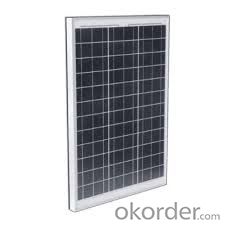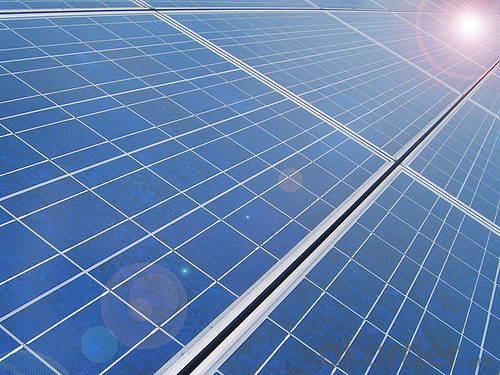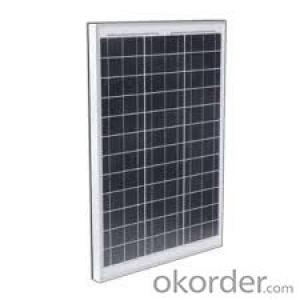80W Poly solar Panel Small Poly Solar Panel CNBM
- Loading Port:
- Qingdao
- Payment Terms:
- TT OR LC
- Min Order Qty:
- 10 set
- Supply Capability:
- 300000 set/month
OKorder Service Pledge
OKorder Financial Service
You Might Also Like
Polycrystalline Solar Modules
CNBM offers a range of small, medium and large polycrystalline solar modules, designed for a range of requirements.


Specifications:
Tolerance | +/-3% |
Cell | Polycrystalline silicon solar cells (156 x 156mm) |
N0. of Cells | 60 (10 x 6) |
Dimension of Modules (mm) | 1650 x 990 x 40 |
Weight (kg) | 25.5 |
Limits:
Operating Temperature | -40~+85? |
Storage Temperature | -40~+85? |
Maximum System Voltage | 1000 VDC max. |
Hail Impact | Diameter of 28mm with impact speed |
Temperature and Coefficients:
NOCT | 48C+/-2? |
Voltage temperature coefficient (%/K) | -0.35 |
Current temperature coefficient (%/K) | 0.05 |
Power temperature coefficient (%/K) | -0.45 |
Characteristics:
Model: | SGM-200P | SGM-210P | SGM-220P |
Max-power voltage Vmp (V) | 29.2 | 29.4 | 29.41 |
Max-power current Imp (A) | 6.85 | 7.14 | 7.48 |
Open-circuit voltage Voc (V) | 36.5 | 36.69 | 36.9 |
Short-Circuit Current Isc (A) | 7.28 | 7.6 | 7.93 |
Max-power Pm(W) | 200 | 210 | 220 |
Model: | SGM-230P |
Max-power voltage Vmp (V) | 29.8 |
Max-power current Imp (A) | 7.72 |
Open-circuit voltage Voc (V) | 37.31 |
Short-Circuit Current Isc (A) | 8.19 |
Max-power Pm(W) | 230 |
STC: Irradiance 1000W/m2, module temperature 25?, AM-=1.5
Poly Crystalline Solar Panels Specifications Range
Maximum Power (Pm) | Dimension | Weight | Operating Voltage (Vmp) | Operating Current (Imp) | Open Circuit Voltage (Voc) | Short Circuit Current (Isc) |
0.45W | 140x80x10mm | 0.08kg | 3.3V | 150mA | 4.6V | 160mA |
1.0W | 162x140x10mm | 0.16kg | 7.5V | 150mA | 10.3V | 160mA |
4.5W | 269x251x23mm | 0.8kg | 16.5V | 0.27A | 20.5V | 0.3A |
10W | 420.1×268.9×22.6mm | 1.92kg | 17.5V | 0.58A | 20.5V | 0.6A |
20W | 425x502x50mm | 3.0kg | 16.8V | 1.19A | 21.0V | 1.29A |
30W | 593x502x22.6mm | 3.9kg | 16.8V | 1.78A | 21.0V | 1.94A |
40W | 655x537x50mm | 5.75kg | 17.3V | 2.31A | 22.1V | 2.54A |
50W | 839x537x50mm | 6.0kg | 17.5V | 2.9A | 21.8V | 3.17A |
65W | 1111x502x50mm | 7.2kg | 17.6V | 3.69A | 22.1V | 3.99A |
80W | 1204x537x50mm | 7.7kg | 17.6V | 4.55A | 22.1V | 4.8A |
- Q:It measured volts before I attached it, and after attaching the voltage regulator device, the voltage dropped down to 3 volts, even when just measuring the difference in the solar panels nodes themselves, suggesting that the entire panels voltage dropped and not just the voltage in the regulator. I tried testing it with a power supply of 7 V 0. A and it works fine, but I don't know why it won't work for the solar panel.
- you cannot treat the open circuit voltage of a solar panel like a voltage source (like a battery.) the load response of the panel doesn't behave that way. small panels and panels that are producing less than about .5A are very happy to have their output voltage pulled down to whatever they're connected to (typically zero.) I observed the same phenomenon when i connected a 2V 725mA panel to a 2V 325mA fan -- the open circuit voltage of 5V dropped to 3V when connected to the fan, and returned to 5V when disconnected. The easiest workaround is to use 2V of rechargable batteries in parallel with the panel so that the battery holds the 2V potential difference and the panel just supplies the current. any excess current charges the batteries, so you might consider whether or not you need some type of charge controller to prevent burning the batteries via overcharging. there are actually very few applications of solar panels connected directly to circuits that i have seen that have any kind of robust performance -- if they work at all, they eventually die/burn themselves out in a couple of months. the best robust designs always have a rechargable battery and charge controller somewhere in the power circuitry to buffer the load circuit from the panel. .
- Q:Can solar panels be installed on bus stops or shelters?
- Yes, solar panels can be installed on bus stops or shelters. In fact, many cities around the world have already implemented solar-powered bus stops and shelters as a sustainable solution to provide clean energy and reduce the environmental impact of public transportation systems. These solar panels can generate electricity to power lighting, information displays, charging stations, and even provide energy back to the grid.
- Q:Can solar panels be used to power a gas station?
- Yes, solar panels can be used to power a gas station. By installing solar panels on the roof or surrounding areas of a gas station, the generated solar energy can be used to power various equipment and operations, including fuel pumps, lighting, air compressors, and other electrical systems. This can help reduce the reliance on traditional grid electricity and lower the environmental footprint of the gas station.
- Q:Tell me complete installation I have one 50Ah battery two 80 watts solar panels about 30 meter DC wire i charge ontroller and 000watt inverter. How i hook two solar panels to charge controller to battery then inverter?
- Wires from panels go to controller input terminals. Controller DC battery terminals to battery so that the controller will protect batteries and split power as required by demand to the inverter. Output DC on controller to inverter. Output AC or outlets on the inverter to AC appliances. One thousand watts is not very much capacity. It will keep your computer running and a lamp to read by. It won't run major appliances. A hair dryer is typically 500 watts and could not be run by this system.
- Q:OK, so if you put solar panels up on a roof, they are busy turning the sun's energy into electricity. So, does that mean the roof (and therefore the house/structure) stays cooler as well? Or does it still get hot, because . . . I dunno, maybe the panels don't convert all the energy, and the spillover still heats up the building.Any links or URLs to scientific answers would be appreciated, but I don't mind hearing from the Average Joe or (Joelle).
- it would depend on the type of paneling. And compared to what. Since it absorbs solar energy, that includes some heat. Compared to white paint, which may reflect more of the heat, it depends.
- Q:I don't know anything about solar and what connections that have to be made. any advice and wisdom would be appreciated. thanks
- Yes. Basically, here's what you need (I'm keeping this general on purpose): The panels themselves -- how large an area depends on average power consumption and how much power you can get on average. That, in turn , depends on climate. You'd need more in Seattle than Tuscon, for example. I'd guess something in the neighborhod of 0 square feet. Depends also on haow many gadgets (printers, etc.) you have. You'll need a power storage system. Lithium gives you the best poser density (of off-the-shelf stuff) but an ordinary car battery works well and is reliable. And, of course, a control system to manage the power generation/storage/use so everything works together without that annoying smell that tells you you just cooked a few hundred bucks worth of equuipment! :)
- Q:Has anyone actually used those kits online like energy4green or earth4energy to build their own solar panels or windmills? I'm so tempted but with my budget can't afford to waste any money. They have a 60 day money back policy but that doesn't include the money used to buy the supplies to try and build the things. My electric bill is almost $300 a month due to my stay at home disabled veteran husband who went from Utah snow to Florida sun and he has to have the AC on really cold. If anyone has actually built one can you tell me of your experience and if it actually is worth the money? I do lots of D.I.Y. projects but am a novice with electric besides installing a ceiling fan and changing out a light switch.
- Electric panels are not feasible for most people. They are two super thin layers of polarized material. When the sun hits them electrons move from the first to the second layer with an amount of force. You can't duplicate that at home. What you could do is setup solar heating panels and run them against a Stirling engine. This technique is typically more efficient than normal electric panels anyway in industry. They have heat on one side and cold on the other to generate force. Hook that to any generator to produce electricity. If you are successful building a home system, blog about it, others will want to know precisely how you did it.
- Q:Can solar panels be installed on a remote island or location?
- Yes, solar panels can be installed on a remote island or location. Solar panels are a flexible and sustainable energy solution that can function independently of the grid, making them suitable for remote areas. They can generate electricity by harnessing sunlight, which is abundant in most locations, including islands. Additionally, advancements in solar technology have made it possible to install panels in challenging environments, such as extreme temperatures or harsh weather conditions.
- Q:How much solar energy does a 2m by a 3m solar panel convert to energy on a sunny day? Assume that the solar cells are 30% efficient.I'm not looking for the answer so much as I need an explanation o how to solve this type of problem... Thanks!!
- You have the area of the solar panel. You know their efficiency. What you need to know now is the energy (per area) delivered by the sun. The energy delivered by the sun can be found on the internet. Earth ,43 – ,32 W/m? (wikipedia) That is offcourse for your solar panels perpendicular to the ray's of the sun. If they are under an angle you should see what the area of the projecton of your solar panel is on a plane perpendicular to the ray's of the sun. So know you have the intensity W/m? and an area (or effective area). Here you go the energy deliverd by the sun. And 30% of it is what you get out of your panels.
- Q:I need to know what the main components of a solar water heater and how they functionThanks if you answer x
- The basic components in home solar heating systems include: Collectors to take the heat from the sun and pass it to a fluid The heat transfer fluid which takes the heat from the collector for use or storage Heat exchangers to transfer the heat from the fluid to a home’s domestic water. Pumps to move the fluid through the collector and/or the exchanger, and sometimes to move the domestic water through the other side of the exchanger. Controllers to run the pumps when there is collector heat available.
1. Manufacturer Overview |
|
|---|---|
| Location | |
| Year Established | |
| Annual Output Value | |
| Main Markets | |
| Company Certifications | |
2. Manufacturer Certificates |
|
|---|---|
| a) Certification Name | |
| Range | |
| Reference | |
| Validity Period | |
3. Manufacturer Capability |
|
|---|---|
| a)Trade Capacity | |
| Nearest Port | |
| Export Percentage | |
| No.of Employees in Trade Department | |
| Language Spoken: | |
| b)Factory Information | |
| Factory Size: | |
| No. of Production Lines | |
| Contract Manufacturing | |
| Product Price Range | |
Send your message to us
80W Poly solar Panel Small Poly Solar Panel CNBM
- Loading Port:
- Qingdao
- Payment Terms:
- TT OR LC
- Min Order Qty:
- 10 set
- Supply Capability:
- 300000 set/month
OKorder Service Pledge
OKorder Financial Service
Similar products
New products
Hot products
Related keywords




























